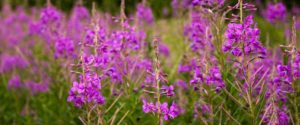Contents
Uses
The roots and leaves have demulcent, tonic and astringent properties and are used in domestic medicine in decoction, infusion and cataplasm, as astringents.
Used much in America as an intestinal astringent.
The plant contains mucilage and tannin.
Benefits
Willowherb is also used by some herbalists to treat intestinal conditions especially irritable bowel syndrome. Herbalists and alternative medicine practitioners recommend adding hot water to a teaspoon of fresh, finely chopped willowherb and allowing it to steep for ten minutes before straining. This makes a tea that’s soothing to the digestive tract.
The leaves and shoot tips of the willowherb plant are edible and contain a variety of natural compounds that have anti-oxidant and anti-inflammatory properties including flavonoids, beta-sitosterol and ellagitannins. It’s the ellagitannins that inhibit alpha-5-reductase and block prostate growth. Some of these ellagitannins also appear to have anti-cancer properties and may be particularly effective for prostate cancer prevention.
Because of its anti-inflammatory and antioxidant properties, willowherb appears to have benefits topically for treating certain inflammatory skin problems such as psoriasis, rosacea and eczema. As an anti-inflammatory, willowherb applied topically to the skin helps to ease irritation and itching. It soothes and eases irritation safely and naturally without the side effects of other treatments like topical steroid creams.
Cautions
Epilobium has been found to sometimes interfere with the hormone progesterone, so if you are pregnant, taking hormone replacement therapy or on birth control pills, you should avoid using this herb.
Interactions
None are recorded.
Other names
Epilobium angustifolium
References
Source: Botanical, http://www.botanical.com/botanical/mgmh/w/wilher23.html#rosuse
SkinStore, http://www.skinstore.com/willowherb.aspx
Gerlindenaturals, http://www.gerlindenaturals.com/blog/willow-herb-active-ingredient.html

